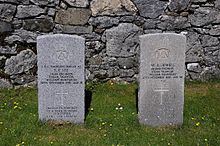Name U-33 Laid down 1 September 1935 Construction started 1 September 1935 Length 64 m Beam 5.85 m | Ordered 25 March 1935 Yard number 556 Commissioned 25 July 1936 Launched 11 June 1936 Draft 4.37 m | |
 | ||
Builder Friedrich Krupp Germaniawerft | ||
German submarine U-33 was a Type VIIA U-boat of Nazi Germany's Kriegsmarine during World War II.
Contents
Her keel was laid down on 1 September 1935 at the Germaniawerft in Kiel. She was launched on 11 June 1936 and commissioned on 25 July with Ottoheinrich Junker in command. He was relieved by Kurt Freiwald on 22 November. Kapitänleutnant (Kptlt.) Hans-Wilhelm von Dresky took over on 29 October 1938 and commanded the boat until her loss.
Rotors from Kriegsmarine's Enigma machine were captured from the survivors, the wiring of which was unknown at that time to British codebreakers at Bletchley Park.
Design
As one of the first ten German Type VII submarines later designated as Type VIIA submarines, U-33 had a displacement of 626 tonnes (616 long tons) when at the surface and 745 tonnes (733 long tons) while submerged. She had a total length of 64.51 m (211 ft 8 in), a pressure hull length of 45.50 m (149 ft 3 in), a beam of 5.85 m (19 ft 2 in), a height of 9.50 m (31 ft 2 in), and a draught of 4.37 m (14 ft 4 in). The submarine was powered by two MAN M 6 V 40/46 four-stroke, six-cylinder diesel engines producing a total of 2,100 to 2,310 metric horsepower (1,540 to 1,700 kW; 2,070 to 2,280 shp) for use while surfaced, two BBC GG UB 720/8 double-acting electric motors producing a total of 750 metric horsepower (550 kW; 740 shp) for use while submerged. She had two shafts and two 1.23 m (4 ft) propellers. The boat was capable of operating at depths of up to 230 metres (750 ft).
The submarine had a maximum surface speed of 17 knots (31 km/h; 20 mph) and a maximum submerged speed of 8 knots (15 km/h; 9.2 mph). When submerged, the boat could operate for 73–94 nautical miles (135–174 km; 84–108 mi) at 4 knots (7.4 km/h; 4.6 mph); when surfaced, she could travel 6,200 nautical miles (11,500 km; 7,100 mi) at 10 knots (19 km/h; 12 mph). U-33 was fitted with five 53.3 cm (21 in) torpedo tubes (four fitted at the bow and one at the stern), eleven torpedoes, one 8.8 cm (3.46 in) SK C/35 naval gun, 220 rounds, and an anti-aircraft gun. The boat had a complement of between forty-four and sixty.
Service history
U-33 took part in Operation Ursula — the German submarine operation in support of Franco's naval forces during the Spanish Civil War from November 1936.
During World War II, U-33 sank 10 ships for a total of 19,261 gross register tons (GRT) in just three war patrols.
On Monday, 20 November 1939 she sank three British steam trawlers. At 10:30 am, Thomas Hankins 14 miles north-west of Tory Island; at 4:00 pm, Delphine 18 miles north-northeast of Tory and at 5:05 pm Sea Sweeper 25 miles west-northwest of Tory. The crew of Thomas Hankins, under the master, M. Hankins, was rescued by another trawler ten hours later and landed in Northern Ireland. They reported that they had been shelled without warning. The second shell went through the bows and the fifth through the boiler, causing the trawler to sink in about 25 minutes.
On Tuesday, 21 November 1939 at 08:30 in rough seas, the trawler FD87 Sulby (from Fleetwood), was sunk by gunfire from U-33 75–80 miles north-west of Rathlin Island. The crew had just managed to launch and push off the two lifeboats as the submarine fired two shells into the trawler amidships and she sank within two minutes. The U-boat commander pointed at the crew as they rowed from their ship and laughed. One of the lifeboats, whose occupants were Harold Blackburn, James Hay, James William Geddes (of Buckie, Banffshire,Scotland), Fred Brunt, Augustus Lewis, Sydney Mellish and Jack Threlfall were picked up the following day by the Tobermory lifeboat. The other lifeboat was lost with five men including the Skipper, Clarence Hudson; Mate John Michael (Jack) Dawson; and deck hands Raymond Randles, James Wood and R.A. Lister.
An hour or so later at the same location, U-33 sank another trawler, William Humphries. The entire crew of 13 men were lost. Two of them were buried in the graveyard of Cill Chriosd on the Isle of Skye.
Fate
In February 1940, U-33, then captained by Hans-Wilhelm von Dresky, had been ordered to lay mines in the Firth of Clyde, in Scotland. However, the minesweeper HMS Gleaner, captained by Lieutenant-Commander Hugh Price, detected the U-boat on the 12th and dropped depth charges over a period of several hours. Eventually, the damaged U-33 was forced to surface and the crew abandoned the boat, which sank soon afterward. 25 men died while 17 survived. Before the boat was abandoned, the U-boat's secret Enigma rotors were distributed amongst a few of the crew, who were instructed to release them into the sea to avoid capture. This was not done, however, and as a result the British captured three rotors, including two (VI and VII), that were only used by Kriegsmarine and for which the wiring was previously unknown.
